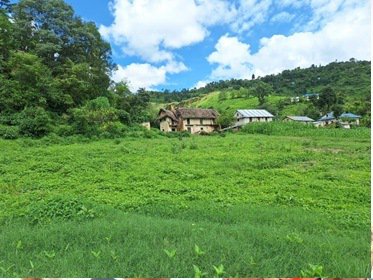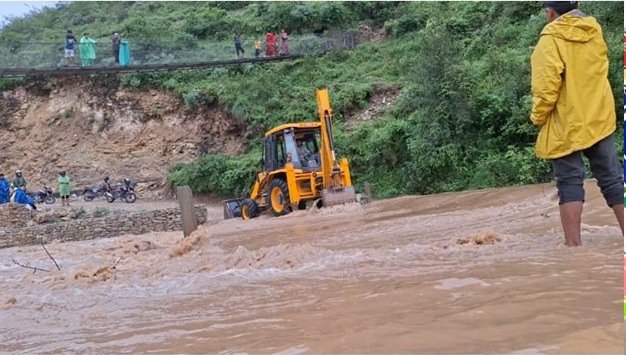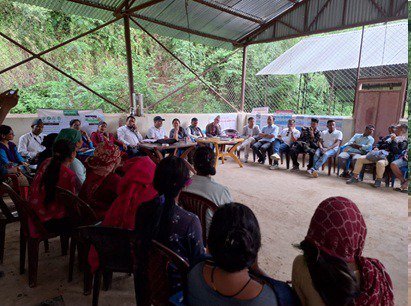As Nepal navigates its path toward development, it faces the complex challenge of balancing economic growth with sustainable and equitable progress. The traditional emphasis on Gross Domestic Product (GDP) as the primary measure of success is increasingly being questioned, both globally and regionally. Olivier De Schutter, the United Nations Special Rapporteur on extreme poverty and human rights, has argued that an obsession with GDP growth is misguided. This article is designed to develop with diverse perspectives taken from various sources and offer to the lens through which Nepal can reassess its development strategy, especially considering its measuring tools to identify statuses and the current pressing impacts of climate change.

Current Economic Landscape
Nepal, a landlocked country in South Asia, has historically relied on agriculture, remittances, and tourism as the main pillars of its economy. Despite its rich cultural heritage and natural beauty, the country remains one of the least developed in the region. As of 2023, Nepal's GDP stood at approximately $36 billion, with a growth rate hovering around 3-4% due to the pandemic and global economic uncertainties. The GDP per capita remains low, reflecting widespread poverty and inequality. However, according to WB development update-2024, Nepal's economic outlook is set to improve, with growth projected to rebound to 3.3% in FY024 and further accelerate to 5% on average over FY025-026. This recovery is supported by easing monetary policy and potential reforms to improve the business environment, which could attract more private investment and boost medium-term growth prospects. However, the country faces risks from external geopolitical uncertainties, domestic demand challenges, and natural disasters, which could impact its economic trajectory. Strengthening the implementation of capital expenditure, boosting business confidence, and enhancing international competitiveness are key to stimulating economic growth and reducing poverty.
Human Development Indices (HDIs)
Nepal's Human Development Index (HDI) in 2022 was 0.602, placing it in the medium human development category. This ranking highlight significant progress in areas like education and healthcare but also underscores persistent challenges. The Multidimensional Poverty Index (MPI) reveals that 28.6% of Nepal's population is multidimensional poor, with acute deprivations in education, health, and living standards. Additionally, the Global Hunger Index (GHI) scores Nepal at 15.0 score with 69th position out of 125 countries globally indicating a moderate level of hunger. These indicators collectively paint a picture of a nation striving to uplift its population amidst numerous developmental hurdles. Moreover, Nepal has improved its position in the Human Development Index (HDI). As per the Global Human Development Report 2023 released by the UNDP, Nepal is ranked at 143th position out of 191 countries of the HDI and its HDI value is 0.610.
Climate Change Impacts
Nepal's vulnerability to climate change is profound, given its diverse topography and reliance on climate-sensitive sectors like agriculture, natural resources, and water sources. Rising temperatures, erratic rainfall patterns, and increased frequency of extreme weather events such as floods and landslides severely impact food security, water resources, and livelihoods. The glacial melt in the Himalayas threatens to disrupt water supplies and exacerbate flooding. The CBS's National Climate Change Survey 2022 highlights significant economic vulnerabilities, with losses totaling Rs 415.44 billion over five years impacting agriculture, water resources, and biodiversity.
Agriculture, constituting 24.60% of GDP and employing over half of Nepal's population, faces heightened risks due to dependence on rainfed farming and climate variability. Surveys reveal new crop diseases, reduced water availability, and altered agricultural productivity. Despite these impacts, there remains a substantial gap in climate change awareness, particularly in rural areas where up to 70.9% of households are unaware of climate impacts.

Water resources, crucial for agriculture and essential services, are significantly affected, with declines in rivulets, streams, wells, and springs. Insufficient rainfall and increased drought incidents exacerbate challenges for both rural and urban water systems. To address these issues, Nepal needs robust climate adaptation strategies, sustainable agricultural practices, and enhanced water resource management. The country's ambitious targets, including achieving net-zero emissions by 2045 and scaling up hydropower investments, aim to mitigate climate impacts and secure a resilient future.
Recent discussions at COP28 have emphasized the need for financial mechanisms to address loss and damage caused by climate change. The proposed Loss and Damage Fund seeks to support countries like Nepal facing severe climate impacts despite almost nill contributions to global emissions. Integrating these considerations into Nepal’s development strategy is crucial for fostering a Green, Resilient, and Inclusive Development (GRID) pathway. Effective governance, international cooperation, and community engagement are pivotal in navigating these complex climate challenges and ensuring sustainable development.
Moving Beyond GDP: Embracing a Human Rights Economy
In other months, De Schutter's critiqued GDP-centric development global model and argued that our blind faith in economic growth is a straitjacket on our imagination and the fight against poverty has suffered heavily. On 2nd July in the UN Assembly, he remembered 1986 and the General Assembly's Declaration on the Right to Development shifted the view of development from purely economic growth to human development, as echoed in the 1990 Human Development Report by Mahbub ul Haq and Amartya Sen: "People are the real wealth of a nation." Political participation, particularly under Article 25 of the ICCPR, is essential for true human development. It breaks the cycle of economic dominance and political influence and ensures social investments in crucial areas like housing, education, and healthcare, countering fiscal pressures and loss of public revenue.
Involving people in poverty in decision-making enhances policy effectiveness and empowers individuals. Protecting union rights (Article 22 ICCPR) ensures that economic progress benefits workers, not just capital owners, addressing the declining share of GDP for workers. Thus, civil and political rights are vital for guiding inclusive development, moving beyond GDP fixation to prioritize well-being and human rights, aligning with SDG target 17. He argues that economic growth, as traditionally pursued, often exacerbates inequalities and environmental degradation, failing to improve the well-being of the most vulnerable populations. Instead, he advocates for a human rights-based approach that prioritizes well-being, equity, and sustainability. This approach suggests that Nepal should shift its focus from mere economic expansion to holistic social and environmental dimensions for climate justice.
Policy Recommendations for Nepal
- Investing in Human Capital: Nepal must enhance its investments in education and healthcare to build a resilient and capable workforce not for only sending to foreign countries but in Nepal for productive works and increasing funding by ensuring equitable access to quality services, especially in remote and marginalized communities where poverty and exclusion yet to be adequatly addressed. By doing so, Nepal can improve its human capital, leading to better health outcomes, higher productivity, and overall economic resilience.
- Sustainable Agriculture and food systems: Nepal is prioritizing sustainable agriculture and food systems to bolster its economy and livelihoods. With agriculture employing a significant portion of the population, the country aims to promote organic farming, enhance irrigation infrastructure, and support smallholder farmers. These efforts are designed to boost productivity, ensure food security, and foster environmental sustainability. By encouraging organic practices, improving water management, and empowering farmers with training and resources, Nepal seeks to enhance resilience against climate change while preserving natural resources. These initiatives underscore Nepal's commitment to sustainable development in its crucial agricultural sector.
- Renewable Energy Development: With abundant hydropower potential and ample sunlight, Nepal can lead in renewable energy. Investing in solar, wind, and hydroelectric projects will reduce reliance on fossil fuels, create jobs, and provide reliable energy to rural areas. This shift not only supports environmental goals but also enhances energy security and economic stability.
- Inclusive Socio-Economic Policies: Economic policies should be designed to reduce inequalities. Inclusive economic policies in Nepal are designed to democratize access to economic opportunities, ensuring that marginalized groups and regions can participate meaningfully in the country's economic growth. By reducing poverty and promoting social cohesion, these policies contribute to overall stability and prosperity. They reflect Nepal's commitment to sustainable development by fostering an environment where all citizens can contribute to and benefit from economic progress.

- Strengthening Disaster Resilience: Enhancing disaster preparedness and response mechanisms is vital. This includes building resilient infrastructure, implementing early warning systems, and providing support to communities to adapt to climate change impacts. Strengthening disaster resilience is essential for protecting lives, livelihoods, and economic assets from the increasing risks posed by climate change.
- Promoting Ecotourism: Nepal's natural and cultural assets are significant tourism draws. Developing ecotourism can generate income while preserving the environment and promoting sustainable practices among tourists and locals alike. Ecotourism can be a powerful tool for economic development that aligns with environmental conservation and cultural preservation.
Measuring Progress: Beyond Traditional Metrics
It would also suggest to transition effectively from a GDP-centric model, Nepal should adopt and emphasize alternative indicators that capture the broader aspects of human and ecological well-being. For this:
- Regularly updating and analyzing HDI to inform policies aimed at improving life expectancy, education, and per capita income.
- Utilizing MPI to address various dimensions of poverty and target interventions where they are most needed.
- Monitoring GHI to ensure food security policies are effective and nutritional needs are met.
- Tracking environmental health and ecosystem vitality to guide sustainable practices and policies through Environmental Performance Index (EPI)
The Role of Global and Regional Co-operations
Nepal's development challenges and climate vulnerabilities are interconnected with global dynamics. Thus, engaging in regional cooperation, particularly within the South Asian Association for Regional Cooperation (SAARC), can help address cross-border environmental issues and promote shared prosperity. Additionally, leveraging international support for climate adaptation and sustainable development initiatives is crucial. Collaborative efforts can enhance resource sharing, knowledge exchange, and collective action towards common goals.
Last but not least, Nepal stands at a crossroads where it can redefine its development path by embracing a holistic approach that prioritizes human rights, ecological wellbeing of peoples and planet, equity and sustainability. De Schutter’s critique of “growthism” offers a compelling framework for this transition. By investing in human capital, promoting sustainable agriculture, developing renewable energy, and adopting inclusive economic policies, Nepal can build a resilient and just economy. The shift from traditional metrics to comprehensive indicators of well-being will ensure that progress truly benefits all Nepalese, paving the way for a sustainable and equitable future.
{Mr. Parajuli, a Human Right Defender, Development Activist and Practitioner; associated with Rural Reconstruction Nepal (RRN) and can be reached at bhanu.parajuli@gmail.com }
- Climate talks: Nepal's Path To Survival And Resilience
- Oct 04, 2024
- Covid19 Crisis: Build Back To 'New Normal'
- Jun 22, 2020













